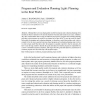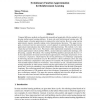413 search results - page 60 / 83 » IT alignment: what have we learned |
AAAI
2000
13 years 9 months ago
2000
Developing tools that allow non-programmers to enter knowledge has been an ongoing challenge for AI. In recent years researchers have investigated a variety ofpromising approaches...
IIE
2007
13 years 7 months ago
2007
Although there are many high-quality models for program and evaluation planning, these models are often too intensive to be used in situations when time and resources are scarce. A...
UAI
2003
13 years 9 months ago
2003
Many practitioners who use EM and related algorithms complain that they are sometimes slow. When does this happen, and what can be done about it? In this paper, we study the gener...
CORR
2010
Springer
13 years 7 months ago
2010
Springer
Temporal difference methods are theoretically grounded and empirically effective methods for addressing reinforcement learning problems. In most real-world reinforcement learning ...
GRAPHICSINTERFACE
2009
13 years 5 months ago
2009
When editing a graphical document, it is common to apply a change to multiple items at once, and a variety of tools exist for selecting sets of items. However, directly selecting ...


